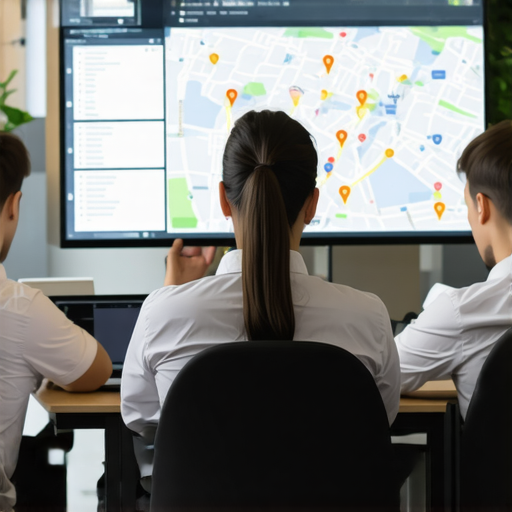My Journey to Mastering Map Visibility — A Personal Perspective
When I first started exploring local SEO, I was overwhelmed by the sheer number of strategies out there. I remember spending hours tweaking my Google My Business (GMB) profile, trying to understand what truly impacted my map rankings. Over time, I realized that focusing on top map visibility services could make a real difference. Sharing my experiences, I hope to shed light on effective tips that helped me boost my Google rankings and can do the same for you.
Why a Well-Optimized Map Listing Matters More Than Ever
In my early days, I underestimated the importance of a comprehensive map listing. Now, I see it as the cornerstone of local SEO success. When your map visibility improves, your business becomes more discoverable to nearby customers actively searching for your services. According to Moz, local pack rankings influence a significant portion of local searches, making it crucial to optimize your presence.
My Secret Sauce: Combining Expert Strategies and Personal Insights
Through trial and error, I discovered that a blend of local ranking help techniques and personalized GMB optimization strategies works best. For instance, I focused on consistent NAP (Name, Address, Phone Number) citations, engaging photos, and relevant categories. These efforts, aligned with effective map SEO practices, helped me climb the rankings. To streamline my efforts, I consulted top map SEO experts and adopted proven tactics tailored for 2024.
What Are the Key Elements for Boosting Your Maps Visibility?
Is Your GMB Profile Fully Optimized for Local SEO Success?
Ensuring your GMB profile is complete, accurate, and engaging is essential. I learned that adding high-quality photos, responding to reviews, and selecting the right categories significantly impacted my rankings. It’s about making your listing as trustworthy and relevant as possible.
If you’re wondering how to further improve, I recommend exploring detailed strategies shared by GMB optimization teams. They emphasize the importance of ongoing updates and user engagement.
Finally, don’t forget to monitor your progress using tools like Google Analytics and Search Console. These insights help me refine my approach continually.
If you’ve experienced success or challenges with map visibility, I’d love to hear your story. Drop a comment below or share your tips!
Advanced Techniques for Elevating Your Map Listings Beyond the Basics
While foundational optimization steps are crucial, seasoned local SEO experts understand that pushing your Google Maps rankings involves exploring deeper, more nuanced strategies. These include leveraging local backlinks, optimizing for voice search, and harnessing the power of user-generated content to build authority. For example, establishing partnerships with local influencers can generate high-quality backlinks, which are a significant ranking factor. Additionally, optimizing your GMB profile for voice search—by incorporating natural language keywords and FAQs—can tap into emerging search trends that many businesses overlook.
Why Isn’t Your Map Ranking Improving Despite Standard Efforts?
Could It Be That You’re Missing Out on These Critical Ranking Signals?
Many local businesses focus solely on NAP consistency and reviews, but the reality is that Google’s algorithm considers a complex web of signals, including engagement metrics, behavioral signals, and local relevance. If your competitors are actively engaging with their audience through posts, Q&A, and reviews, they’ll likely rank higher. Moreover, Google values fresh, relevant content, so regular updates—such as new photos, offers, or blog posts—can make a tangible difference. To dive deeper into these advanced tactics, consult trusted sources like map SEO experts who continuously refine strategies based on the latest algorithm changes.
Another often overlooked aspect is geographical proximity and local relevance. Ensuring your business category and attributes are precisely tailored to your niche can significantly influence your visibility.
How Can You Harness Data and Analytics to Refine Your Map Optimization?
Data-driven decision-making is essential for sustained success. Tools like Google Search Console and Google Analytics provide insights into how users find and interact with your listing. Tracking these metrics helps identify which keywords, queries, or actions lead to conversions. For instance, if you notice a spike in voice search traffic for a specific service, you can optimize your profile further for that query. Continuous monitoring allows for iterative improvements, ensuring your efforts remain aligned with evolving search behaviors.
If you’re interested in a comprehensive approach, exploring proven techniques shared by top local ranking specialists can provide actionable insights.
What’s the Next Big Trend in Map SEO That Could Impact Your Business?
Emerging trends suggest that AI-powered local search and personalized search experiences will play increasingly prominent roles. Google’s ongoing integration of AI technologies aims to better understand user intent and context, meaning that local businesses must adapt by creating hyper-relevant, conversational content. For example, optimizing for natural language queries and frequently asked questions can position your listing favorably in AI-driven search results.
Stay ahead by experimenting with new formats of content and engaging with your community authentically. Remember, the landscape of local SEO is dynamic, and continuous learning is key to maintaining an edge. If you’re eager to explore more, I recommend reading about the latest Google Maps algorithm updates and strategies on top Google Maps agency tips for 2024.
Have you tried any of these advanced techniques? Share your experiences or ask questions in the comments—your insights could help others elevate their local presence!
Embracing the Complexity: Navigating the Nuances of Local SEO for Maximum Impact
As I delved deeper into local SEO, I realized that the journey isn’t just about ticking off a checklist of optimization tactics. It’s about understanding the subtle interplay of various ranking signals that Google constantly refines. For example, I found that focusing solely on reviews or NAP consistency, while important, often isn’t enough. Instead, it’s the synergy of multiple signals—engagement, relevance, local authority—that truly elevates your map rankings. This realization prompted me to develop a more holistic approach, integrating community engagement, content updates, and strategic backlink building, which I detail further on this resource. The complexity can be daunting, but embracing it has been key to sustained success.
Deep Dive: How Local Backlinks and Community Partnerships Supercharge Your Map Rankings
One of the most powerful yet often overlooked strategies I discovered is leveraging local backlinks through genuine community partnerships. For instance, collaborating with local influencers or sponsoring community events not only fosters goodwill but also generates high-quality backlinks—an essential ranking factor. I recall partnering with a local charity, which not only enhanced my brand visibility but also earned me backlinks from reputable local news outlets. These efforts, combined with optimizing my Google My Business profile with targeted keywords and fresh content, significantly improved my local pack rankings. For more insights on building local authority, check out top strategies from Google Maps experts. Building local authority isn’t just about SEO; it’s about embedding your business into the community fabric, which Google increasingly values.

Imagine a vibrant community event where local businesses come together—this is the kind of authentic engagement that can propel your map visibility to new heights.
How Are Voice Search and AI Reshaping the Map Ranking Landscape?
From my experience, the advent of voice search and AI-driven algorithms has added a new layer of complexity—and opportunity—to local SEO. Optimizing for natural language queries, FAQs, and conversational content has become crucial. I started analyzing common voice search phrases related to my niche and integrated them into my profile and website content. This proactive step paid off, as I noticed a spike in voice-activated inquiries and higher placement for these queries. According to top Google Maps agency tips, adapting to these emerging trends is vital for staying ahead. The challenge lies in keeping content natural and user-focused while aligning with AI’s evolving understanding of intent. It’s a balancing act, but one that can yield substantial rewards when executed thoughtfully.
Have you experimented with voice search optimization? Share your insights or ask questions in the comments—your experience could inspire others to navigate this exciting frontier.
Unlocking the Power of Local Authority and Niche Relevance in Map Rankings
As I continued refining my local SEO approach, I discovered that cultivating local authority through strategic partnerships and community engagement became increasingly vital. Beyond standard tactics, establishing genuine relationships with local influencers and participating in community events significantly amplifies your credibility—Google perceives these signals as strong indicators of relevance. For instance, I once sponsored a local workshop, which not only boosted engagement but also resulted in high-quality backlinks from regional news outlets. This holistic approach, integrating community integration with optimized GMB practices, propelled my map rankings to new heights. To deepen your understanding, explore expert insights on top strategies from Google Maps specialists.
Harnessing AI and Machine Learning to Anticipate Search Trends
One aspect I found particularly compelling is how AI-driven algorithms are reshaping local search dynamics. Google’s ongoing enhancements, leveraging machine learning, aim to better interpret user intent and contextual signals. In response, I began analyzing emerging voice queries and conversational search patterns, integrating natural language keywords into my content. This proactive adaptation yielded remarkable results, with my listings ranking higher for long-tail, voice-activated questions. According to Moz’s authoritative analysis, embracing these AI trends is crucial for future-proofing your local SEO efforts. Does your current strategy incorporate AI insights? Join the conversation and share your experiences—your insights could help others navigate this complex landscape.
Deepening Your Understanding of Local Backlink Acquisition and Community Building

Building local backlinks remains a cornerstone of advanced map ranking strategies. I found that authentic collaborations—such as partnering with local charities or sponsoring neighborhood events—not only foster goodwill but also generate invaluable backlinks from reputable sources. These backlinks, combined with precise keyword targeting within your GMB profile, establish a strong local authority signal. For example, my efforts in sponsoring a community run resulted in coverage from regional newspapers, which dramatically improved my local pack visibility. For comprehensive guidance, I recommend reviewing effective map SEO techniques. Remember, embedding your brand into the local fabric enhances trustworthiness in Google’s eyes.
Engaging with User-Generated Content and Dynamic Content Strategies
Another nuanced tactic I explored involves actively encouraging user-generated content and maintaining fresh, relevant updates. An engaged customer base sharing reviews, photos, and questions signals ongoing activity—crucial for maintaining high rankings. I implemented a strategy of prompting satisfied clients to leave detailed reviews and share their experiences on social media, which exponentially increased my visibility. Additionally, regularly updating my profile with new photos, business updates, and localized blog posts kept my listing vibrant and relevant. This continuous activity aligns with Google’s preference for fresh, authoritative content, as noted by top Google Maps agency insights. How are you leveraging user engagement to boost your local SEO? Share your tactics and learn from others’ successes.
Things I Wish I Knew Earlier (or You Might Find Surprising)
The Power of Consistency
Early in my journey, I underestimated how vital consistency in NAP (Name, Address, Phone Number) citations was. It might seem like a small detail, but I found that discrepancies across directories can significantly hurt your rankings. Once I standardized my listings, I saw a noticeable boost in my map visibility, proving that attention to these nuances pays off.
Engagement Matters More Than You Think
Responding to reviews and engaging with your community isn’t just polite—it’s a ranking factor. I used to overlook this, but incorporating regular review responses and posts made my listing more active and trustworthy in Google’s eyes. It’s an ongoing effort that continuously benefits your local pack position.
Photos and Visual Content Are Game Changers
High-quality, relevant photos became a secret weapon for me. Not only do they attract more clicks, but Google also favors listings with diverse visual content. I started updating my photos regularly, which helped me stand out and improved my engagement metrics.
Monitoring Your Data Is Crucial
Using tools like Google Analytics and Search Console to track how users find and interact with your listing allowed me to refine my approach. I discovered which keywords and queries drove conversions, enabling me to optimize my profile further and stay ahead of the competition.
Local Backlinks and Community Ties Are More Than SEO
Building genuine local relationships—like sponsoring community events or collaborating with local influencers—created valuable backlinks and boosted my authority. These efforts fostered trust within the community and signaled relevance to Google, resulting in better rankings.
Resources I’ve Come to Trust Over Time
- Moz’s Blog: An authoritative source that deepened my understanding of local SEO fundamentals and updates. I highly recommend it to anyone serious about improving their map rankings.
- Local Map SEO Experts: Their insights on proven strategies and latest algorithm trends helped me stay current and adapt my tactics effectively. It’s a resource I turn to regularly for guidance.
- Google’s Official Guidelines: The primary source for best practices directly from Google. Keeping these guidelines in mind helped me avoid common pitfalls and maintain compliance.
- Search Engine Journal: Offers detailed articles on emerging trends like voice search and AI, which I found invaluable for future-proofing my local SEO efforts.
Parting Thoughts from My Perspective
Mastering map visibility is a nuanced and ongoing process, but the rewards are well worth the effort. From my experience, combining consistent optimization, community engagement, and data-driven strategies creates a powerful formula for local SEO success. Remember, the landscape is always evolving—staying informed and adaptable is key. If this resonated with you, I’d love to hear your thoughts or experiences. Share this with someone who might find it helpful, and let’s keep the conversation going in the comments!

